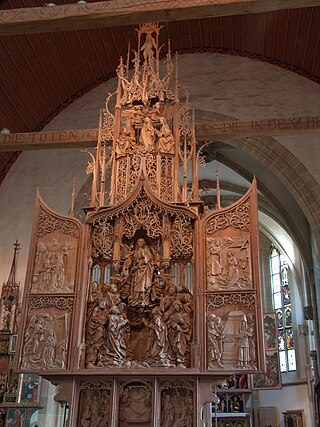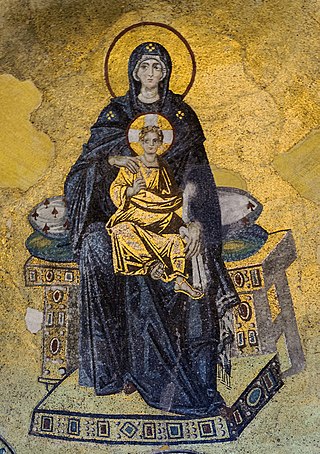A cultural movement is a change in the way a number of different disciplines approach their work. This embodies all art forms, the sciences, and philosophies. Historically, different nations or regions of the world have gone through their own independent sequence of movements in culture, but as world communications have accelerated this geographical distinction has become less distinct. When cultural movements go through revolutions from one to the next, genres tend to get attacked and mixed up, and often new genres are generated and old ones fade.: These changes are often reactions against the prior cultural form, which typically has grown stale and repetitive. An obsession emerges among the mainstream with the new movement, and the old one falls into neglect – sometimes it dies out entirely, but often it chugs along favored in a few disciplines and occasionally making reappearances.

The Ottonian dynasty was a Saxon dynasty of German monarchs (919–1024), named after three of its kings and Holy Roman Emperors named Otto, especially its first Emperor Otto I. It is also known as the Saxon dynasty after the family's origin in the German stem duchy of Saxony. The family itself is also sometimes known as the Liudolfings, after its earliest known member Count Liudolf and one of its most common given names. The Ottonian rulers were successors of the Germanic king Conrad I, who was the only Germanic king to rule in East Francia after the Carolingian dynasty and before this dynasty.

The Renaissance is a period in history and a cultural movement marking the transition from the Middle Ages to modernity, covering the 15th and 16th centuries and characterized by an effort to revive and surpass the ideas and achievements of classical antiquity; it was associated with great social change in most fields and disciplines, including art, architecture, politics, literature, exploration and science. It began in the Republic of Florence, spread to the rest of Italy and later throughout Europe. The term rinascita ("rebirth") first appeared in Lives of the Artists by Giorgio Vasari, while the corresponding French word renaissance was adopted into English as the term for this period during the 1830s.

Classicism, in the arts, refers generally to a high regard for a classical period, classical antiquity in the Western tradition, as setting standards for taste which the classicists seek to emulate. In its purest form, classicism is an aesthetic attitude dependent on principles based in the culture, art and literature of ancient Greece and Rome, with the emphasis on form, simplicity, proportion, clarity of structure, perfection, restrained emotion, as well as explicit appeal to the intellect. The art of classicism typically seeks to be formal and restrained: of the Discobolus Sir Kenneth Clark observed, "if we object to his restraint and compression we are simply objecting to the classicism of classic art. A violent emphasis or a sudden acceleration of rhythmic movement would have destroyed those qualities of balance and completeness through which it retained until the present century its position of authority in the restricted repertoire of visual images." Classicism, as Clark noted, implies a canon of widely accepted ideal forms, whether in the Western canon that he was examining in The Nude (1956).

The Carolingian Renaissance was the first of three medieval renaissances, a period of cultural activity in the Carolingian Empire. Charlemagne's reign led to an intellectual revival beginning in the 8th century and continuing throughout the 9th century, taking inspiration from ancient Roman and Greek culture and the Christian Roman Empire of the fourth century. During this period, there was an increase of literature, writing, visual arts, architecture, music, jurisprudence, liturgical reforms, and scriptural studies. Carolingian schools were effective centers of education, and they served generations of scholars by producing editions and copies of the classics, both Christian and pagan.

The medieval art of the Western world covers a vast scope of time and place, with over 1000 years of art in Europe, and at certain periods in Western Asia and Northern Africa. It includes major art movements and periods, national and regional art, genres, revivals, the artists' crafts, and the artists themselves.

The culture of Europe is diverse, and rooted in its art, architecture, traditions, cuisines, music, folklore, embroidery, film, literature, economics, philosophy and religious customs.

Pre-Romanesque art and architecture is the period in European art from either the emergence of the Merovingian kingdom in about 500 AD or from the Carolingian Renaissance in the late 8th century, to the beginning of the 11th century Romanesque period. The term is generally used in English only for architecture and monumental sculpture, but here all the arts of the period are briefly described.

Carolingian art comes from the Frankish Empire in the period of roughly 120 years from about 780 to 900—during the reign of Charlemagne and his immediate heirs—popularly known as the Carolingian Renaissance. The art was produced by and for the court circle and a group of important monasteries under Imperial patronage; survivals from outside this charmed circle show a considerable drop in quality of workmanship and sophistication of design. The art was produced in several centres in what are now France, Germany, Austria, northern Italy and the Low Countries, and received considerable influence, via continental mission centres, from the Insular art of the British Isles, as well as a number of Byzantine artists who appear to have been resident in Carolingian centres.

Ottonian art is a style in pre-romanesque German art, covering also some works from the Low Countries, northern Italy and eastern France. It was named by the art historian Hubert Janitschek after the Ottonian dynasty which ruled Germany and Northern Italy between 919 and 1024 under the kings Henry I, Otto I, Otto II, Otto III and Henry II. With Ottonian architecture, it is a key component of the Ottonian Renaissance. However, the style neither began nor ended to neatly coincide with the rule of the dynasty. It emerged some decades into their rule and persisted past the Ottonian emperors into the reigns of the early Salian dynasty, which lacks an artistic "style label" of its own. In the traditional scheme of art history, Ottonian art follows Carolingian art and precedes Romanesque art, though the transitions at both ends of the period are gradual rather than sudden. Like the former and unlike the latter, it was very largely a style restricted to a few of the small cities of the period, and important monasteries, as well as the court circles of the emperor and his leading vassals.

The Renaissance of the 12th century was a period of many changes at the outset of the High Middle Ages. It included social, political and economic transformations, and an intellectual revitalization of Western Europe with strong philosophical and scientific roots. These changes paved the way for later achievements such as the literary and artistic movement of the Italian Renaissance in the 15th century and the scientific developments of the 17th century.

The Ottonian Renaissance was a renaissance of Byzantine and Late Antique art in Central and Southern Europe that accompanied the reigns of the first three Holy Roman Emperors of the Ottonian dynasty: Otto I (936–973), Otto II (973–983), and Otto III (983–1002), and which in large part depended upon their patronage. The leading figures in this movement were Pope Sylvester II and Abbo of Fleury. Renewed contact between the Ottonian court and Byzantine Constantinople spurred the hybridisation of Eastern-Byzantine and Western-Latin cultures, particularly in arts, architecture and metalwork, while the Ottonians revitalised the cathedral school network which promoted learning based on the seven liberal arts. Ottonian intellectual activity was largely a continuation of Carolingian works, but circulated mainly in the cathedral schools and the courts of bishops, rather than the royal court.

Carolingian architecture is the style of north European Pre-Romanesque architecture belonging to the period of the Carolingian Renaissance of the late 8th and 9th centuries, when the Carolingian dynasty dominated west European politics. It was a conscious attempt to emulate Roman architecture and to that end it borrowed heavily from Early Christian and Byzantine architecture, though there are nonetheless innovations of its own, resulting in a unique character.

German art has a long and distinguished tradition in the visual arts, from the earliest known work of figurative art to its current output of contemporary art.

Macedonian Renaissance is a historiographical term used for the blossoming of Byzantine culture in the 9th–11th centuries, under the eponymous Macedonian dynasty (867–1056), following the upheavals and transformations of the 7th–8th centuries, also known as the "Byzantine Dark Ages". The period is also known as the era of Byzantine encyclopedism, because of the attempts to systematically organize and codify knowledge, exemplified by the works of the scholar-emperor Constantine VII Porphyrogennetos.

The architecture of Germany has a long, rich and diverse history. Every major European style from Roman to Postmodern is represented, including renowned examples of Carolingian, Romanesque, Gothic, Renaissance, Baroque, Classical, Modern and International Style architecture.
The following outline is provided as an overview of and topical guide to the Renaissance:
The medieval renaissances were periods of cultural renewal across medieval Western Europe. These are effectively seen as occurring in three phases - the Carolingian Renaissance, Ottonian Renaissance and the Renaissance of the 12th century.

The Timurid Renaissance or Turkic Renaissance was a historical period in Asian and Islamic history spanning the late 14th, the 15th, and the early 16th centuries. Following the gradual downturn of the Islamic Golden Age, the Timurid Empire, based in Central Asia ruled by the Timurid dynasty, witnessed the revival of arts and sciences. Its movement spread across the Muslim world. The French word renaissance means "rebirth", and defines a period as one of cultural revival. The use of the term for the description of this period has raised reservations among scholars, some of whom see it as a swan song of Timurid culture.














